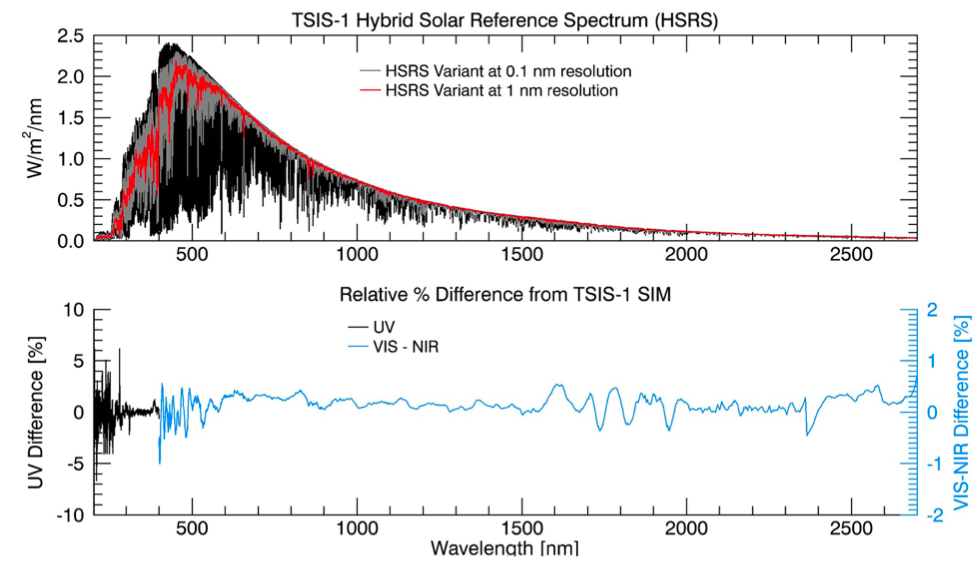TSIS-1 HSRS
- text
-
TSIS-1 Hybrid Solar Reference Spectrum (CEOS endorsed)
The Sun's irradiance spectrum is used in many applications, such as constraining the solar forcing in climate models and converting measured satellite radiance to reflectance. A growing body of literature has provided evidence that the currently available solar reference spectra differ by more than their reported uncertainties. Such differences lead to biased results when different reference spectra are adopted in the aforementioned applications. This motivates the work to provide a new high-resolution solar reference spectrum at higher accuracy than any previously reported.
The Total and Spectral Solar Irradiance Sensor-1 (TSIS-1) Hybrid Solar Reference Spectrum (HSRS) has been developed by applying a modified spectral ratio method to normalize very high spectral resolution solar line data to the absolute irradiance scale of the TSIS-1 Spectral Irradiance Monitor (SIM) and the CubeSat Compact SIM (CSIM). The high spectral resolution solar line data are the Air Force Geophysical Laboratory ultraviolet solar irradiance balloon observations, the ground-based Quality Assurance of Spectral Ultraviolet Measurements In Europe Fourier transform spectrometer solar irradiance observations, the Kitt Peak National Observatory solar transmittance atlas, and the semi-empirical Solar Pseudo-Transmittance Spectrum atlas. The TSIS-1 HSRS spans 202–2730 nm at 0.01 to ∼0.001 nm spectral resolution with uncertainties of 0.3% between 460 and 2365 nm and 1.3% at wavelengths outside that range.
The ability to produce such a data set is due to the state-of-the-art measurements of the Sun's irradiance spectrum made since March 2018 by the next-generation Spectral Irradiance Monitor (SIM) instrument on the Total and Spectral Solar Irradiance Sensor-1 (TSIS-1) satellite mission and the Compact SIM (CSIM) technology demonstration mission. The TSIS-1 SIM and CSIM have order-of-magnitude reduction in uncertainty relative to predecessor instruments primarily because of a first-of-its-kind spectral radiometric calibration facility capable of characterizing the instruments to higher fidelity.

Figure. (top) The TSIS-1 Hybrid Solar Reference Spectrum (black) and two variants at lower resolution. (bottom)
References
Title: The TSIS-1 Hybrid Solar Reference Spectrum
Authors: Coddington, O. M., Richard, E. C., Harber, D., Pilewskie, P., Woods, T. N., Chance, K., et al. (2021).
Geophysical Research Letters, 48, e2020GL091709. https://doi.org/10.1029/2020GL091709
URL: https://lasp.colorado.edu/lisird/data/tsis1_hsrs
CEOS WGCV recommendation
In March 2022, the TSIS-1 HSRS was recommended as the new solar irradiance reference spectrum by the Committee on Earth Observation Satellites (CEOS) Working Group on Calibration and Validation (WGCV).
